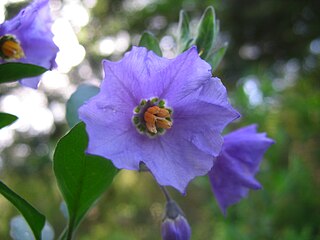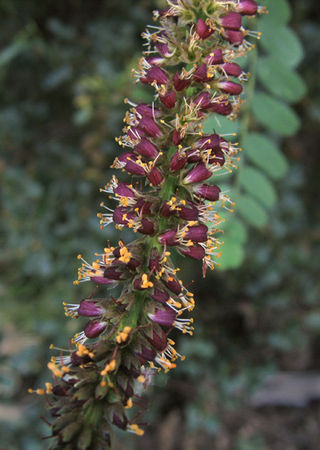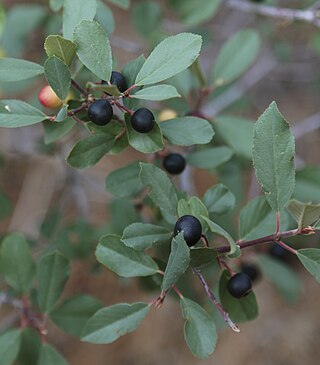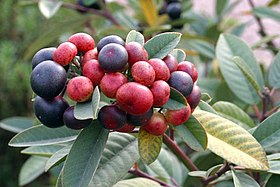
Frangula is a genus of about 35 species of flowering shrubs or small trees, commonly known as alder buckthorn in the buckthorn family Rhamnaceae. The common name buckthorn is also used to describe species of the genus Rhamnus in the same family and also sea-buckthorn, Hippophae rhamnoides in the Elaeagnaceae.

Fremontodendron californicum, with the common names California flannelbush, California fremontia, and flannel bush, is a flowering shrub native to diverse habitats in southwestern North America.

Prunus ilicifolia is native to the chaparral areas of coastal California, Baja California, and Baja California Sur. as well as the desert chaparral areas of the Mojave desert.

Solanum xanti, known commonly as chaparral nightshade, purple nightshade, and San Diego nightshade, is a member of the genus Solanum. It is native to the Western United States in Arizona, California, Nevada, and Oregon, and to northwest Mexico in Baja California.

Amorpha californica is a species of flowering plant in the legume family known by the common name California false indigo.

Coffee berry may refer to:

Rhamnus cathartica, the European buckthorn, common buckthorn, purging buckthorn, or just buckthorn, is a species of small tree in the flowering plant family Rhamnaceae. It is native to Europe, northwest Africa and western Asia, from the central British Isles south to Morocco, and east to Kyrgyzstan. It was introduced to North America as an ornamental shrub in the early 19th century or perhaps before, and is now naturalized in the northern half of the continent, and is classified as an invasive plant in several US states and in Ontario, Canada.

Frangula alnus, commonly known as alder buckthorn, glossy buckthorn, or breaking buckthorn, is a tall deciduous shrub in the family Rhamnaceae. Unlike other "buckthorns", alder buckthorn does not have thorns. It is native to Europe, northernmost Africa, and western Asia, from Ireland and Great Britain north to the 68th parallel in Scandinavia, east to central Siberia and Xinjiang in western China, and south to northern Morocco, Turkey, and the Alborz in Iran and the Caucasus Mountains; in the northwest of its range, it is rare and scattered. It is also introduced and naturalised in eastern North America.

Ephedra californica is a species of Ephedra, known by the common names California jointfir, California ephedra, desert tea, Mormon tea, and cañatillo.

Sambucus racemosa is a species of elderberry known by the common names red elderberry and red-berried elder.

Brickellia californica, known by the common name California brickellbush, is a species of flowering plant in the family Asteraceae.

Orobanche californica, known by the common name California broomrape, is a species of broomrape. It is a parasitic plant growing attached to the roots of other plants, usually members of the Asteraceae.

Rhamnus alnifolia is a species of flowering plant in the buckthorn family known by the common names alderleaf buckthorn, or alder buckthorn. Unlike other "buckthorns", this alder buckthorn does not have thorns. It is native to North America, where it is known mainly from the southern half of Canada and the northern half of the United States and California. It can be found in forested habitat.

Rhamnus crocea subsp. ilicifolia, synonym Rhamnus ilicifolia, is a subspecies of flowering plant in the buckthorn family, known by the common name hollyleaf redberry. It is native to western North America, where it is a common plant growing in many types of habitat, including chaparral and wooded areas, from Oregon through California, to Baja California and Arizona.
Rhamnus crocea subsp. pirifolia, synonym Rhamnus pirifolia, is a subspecies of tree and shrub in the buckthorn family known by the common name island redberry. It is an island endemic which is known only from the Channel Islands of California and Guadalupe Island off Baja California. Its habitat consists of coastal sage scrub and chaparral.

Frangula rubra is a species of flowering plant in the buckthorn family known by the common names red buckthorn and Sierra coffeeberry.

Solidago californica is a species of goldenrod known by the common name California goldenrod.

Rhamnus alaternus is a species of flowering plant in the buckthorn family Rhamnaceae, known by the common names Italian buckthorn or Mediterranean buckthorn. It is a hardy medium-sized evergreen shrub with fragrant flowers.






















